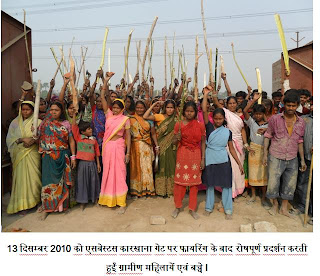Mr. Sumit Sen
Resident Editor
The Times of India
Patna (Kolkata Market)
Subject-Massive Protest Against Killer Asbestos Plant in Bihar
Sir,
Apropos “Asbestos firm cries foul over
'protests<http://timesofindia.indiatimes.com/city/patna/Asbestos-firm-cries-foul-over-protests/articleshow/7220092.cms>'”
(The Times of India, Patna, Jan 5, 2011), World Health Organisation (WHO)
says, "currently about 125 million people in the world are exposed to
asbestos at the workplace. As per its estimates, more than 107,000 people
die each year from asbestos-related lung cancer, mesothelioma and asbestosis
resulting from occupational exposures. One in every three deaths from
occupational cancer is estimated to be caused by asbestos. In addition, it
is estimated that several thousands of deaths can be attributed annually to
exposure to asbestos in the living environment."
Unpardonable callousness on the part of Bihar government in the matter of
proposed asbestos plant is facing bitter resistance by the villagers. The
agitation has huge potential to become Bihar's Singur if the plant is not
stopped. There has been firing on non-violent protesters on 13th December
and on 9th December when a team of doctors visited the village at the behest
of a Patna based Nagrik Forum to hear the health concerns of the villagers,
the villagers were lathicharged. In protest, the villagers are sitting on
Dharna.
What is poisonous in 52 countries cannot become non-poisonous in India.
Human biology is the same everywhere.
Canada which is one of the bigger suppliers of asbestos has decontaminated
its parliament and has adopted a no home use policy. Why should villagers
Chainpur-Bishunpur in Muzaffarpur, Bihar be exposed to killer fibers of
asbestos. On 30th December, Turkey has joined the group of countries that
have banned trade and use of asbestos of all kinds.
Kerala Human Rights Commission (KHRC) has ruled that exposing Indians to
asbestos is a human rights violation. This paves the way for the eventual
complete ban on asbestos and its products. On January 31, 2009, the KHRC
ruled that the government should take steps to phase out asbestos roofing
from all schools in the state.
National Human Rights Commission (NHRC) has passed an order recommending
that the asbestos sheets roofing be replaced with roofing made up of some
other material. The Annual Report of NHRC 2003-2004 refers to a Report
entitled “Asbestos – Health and Environment – an in-depth Study” submitted
by the Institute of Public Health Engineers, India. NHRC is currently
examining an application to make our country asbestos free at the earliest.
Even if one asbestos fibre reaches the right place, it causes irreversible
damage - leading to asbestosis, lung cancer or mesothelioma. On August 18,
2003, Mrs Sushma Swaraj, the then Union Minister of Health and Family
Welfare informed the Parliament "…long-term exposure to any type of asbestos
can lead to development of asbestosis, lung cancer and mesothelioma."
Asbestos is not deemed safe even by Government of India that's why is
asbestos mining is banned in India. Some 52 countries has banned asbestos.
In 2006 alone there were more than 1,000 mesothelioma deaths (asbestos
related fatal disease) in Japan. In US 10, 000 people are dying of asbestos
disease.
Balmukund asbestos company got clearance by misleading Central Pollution
Control Board saying the site of the plant is a 'barren' land in its
Environment Impact Assessment (EIA) report although its a fertile land. It
has been pointed out since May 2010 that this company has violated all the
relevant provisions of the EIA Notification, 2006. The Union Environment
Ministry has been apprised of the situation and it is learnt that they are
in the process of initiating action against the company.
When Mr S S Ahluwalia, former member, Parliamentary Standing Committee on
Science, Technology, Environment & Forests was briefed on 7th January, he
was surprised to note that India as a country still uses asbestos despite
knowing that almost all the developed countries have banned it. He promised
to raise the issue of the proposed asbestos plant in Bihar at his
party's *national executive meeting* underway in Guwahati.
A letter to this effect has been sent to Dr C P Thakur, former, Union
Health Minister and Member, Parliamentary Standing Committee on
Chemicals and Fertilizers as well. Almost all the MPs from Bihar has been
apprised of the imminent public health crisis due to asbestos plants proposed
in Bhojpur, Vaishali and Muzaffarpur.
Such hazardous plants should not be allowed even on non-agricultural lands
and plans must be urgently made to decontaminate existing asbestos laden
buildings in Bihar and elsewhere.
With Best Regards
Dr. Ishwari Prasad
(Rtd. Professor<Economics)
Jawaharlal Nehru University
New Delhi














